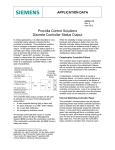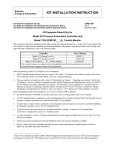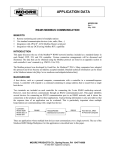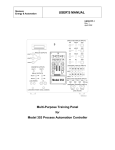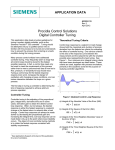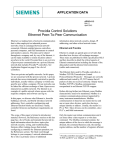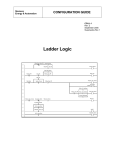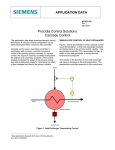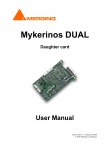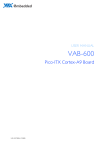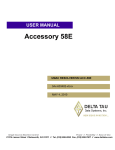Download Application Data - Lesman Instrument Company
Transcript
Siemens Energy & Automation Application Data AD353-112 Rev. 1 October 2001 DISCRETE CONTROLLER STATUS OUTPUT In critical applications, it is often desirable to have a controller status signal to indicate that the controller is functional. This publication explains how to configure a discrete controller status output signal. The status signal is a normally closed contact that becomes an open contact in the event of a catastrophic controller failure. Loss of network communication detection can be incorporated in the configuration. The status output contact is often used to activate a user supplied annunciator and emergency shutdown circuit. For example, in a boiler application, the Burner Management System (BMS) typically monitors the combustion controller. If the combustion controller fails, the BMS forces a safety shut down. While the reliability of today’s process control hardware and software is better than ever, the discrete controller status techniques described here can provide an additional level of safety. The techniques developed in this publication require one of the following controllers and the controller must have the optional I/O Expander board. Moore 352P Single-Loop Digital Controller Moore 353 Process Automation Controller Moore 354N Universal Loop Controller Procidia™ i|pac™ Internet Control System CATASTROPHIC CONTROLLER FAILURE The intent of the controller status is to signal a catastrophic controller failure where the controller is unable to regulate the process. Non-catastrophic failures will not activate the controller status but will initiate an error code as described in the controller’s User’s Manual (refer to Reference Publications section). A catastrophic controller failure is usually a hardware failure. A probable scenario is the loss of electrical power to the controller or the failure of the controller’s internal power supply. A failure of the microprocessor (hardware or software) is much less probable, but it too would render the controller nonfunctional. Loss of an analog input or output would be catastrophic since the process variable could not be measured or controlled. INTERNAL WATCHDOG AND CONTROLLER RESET The controller CPU has two internal watchdogs that monitor controller operation. One is software and the other is hardware. The microprocessor periodically resets the watchdog timers. In the event that a watchdog fails to be reset, that watchdog will force a controller reset. During the reset, all on-board analog outputs go to zero mA and all on board discrete outputs go to logic state zero. CONTROLLER STATUS SIGNAL The basic controller status signal is built by configuring the output of a NOR function block to input C of an ROUT1 or ROUT2 relay output function block, as shown in the figure below. ROUT is a mechanical relay located on the I/O Expander board. Relay contacts are available for user wiring at the controller terminals. This configuration will energize the relay output and maintain the normally open contact closed during normal operation. In the event of a catastrophic failure, the normally open contact will open. Therefore, the controller status signal, at terminals 28 and 29 in the figure on the next page, is a closed contact during normal controller operation and an open contact when a controller fails. The ROUT block must be configured for direct (Dir) “Action.” AD353-112 Optional connections to expand Controller Status capability. “On-Line Error and Station Status Codes” table located in the Error Codes section of the User’s Manual. Only the error codes mapped to Modbus register 40002 and LIL channel 4 affect the Station Error bit. These codes are listed on page 3. Controller Terminals, Moore 353 Shown QS (Quality Status) output from AIN, DIN, or other I/O block. NC NOR QS (Quality Status) output from AIL block or i|pac Ubus i|o block. See text for Delay Timer recommendation. 27 MG00400a SE (Station Error) from ODA, ODC or other block. 28 ROUT1 NO 29 To incorporate the Station Error into the controller status connect any SE output to a NOR block input, as shown in the figure. ANALOG INPUT/OUTPUT QUALITY STATUS The AIN (Analog Input) and AOUT (Analog Output) blocks have a Quality Status output. This output is normally low and goes high when the quality status is “bad.” There are two typical scenarios for a catastrophic failure. The most likely is a power failure, either loss of power to the controller or failure of the controller’s power supply. The second, which is less likely, is the failure of the microprocessor. For an AIN block, a high at the QS output indicates that there is an A/D conversion failure or that the 1-5 Vdc input signal is below 0.6 V. The low voltage input signal implies an open circuit or possibly a failed transmitter or other field device. Note that when a 2-wire transmitter fails it will not necessarily cause the output current to fall below 2.4 mA. Loss of external power to the controller will allow the relay contacts to open signaling a catastrophic failure. The controller’s internal power supply provides two output voltages: 5 Vdc and 24 Vdc. The 5V source is used to power the CPU and the discrete I/O. The 24V source powers the standard analog inputs and outputs and to energize the ROUT relays. For an AOUT block, a high at the QS output indicates a high impedance or an open circuit. If an analog block quality status is to be included in the controller status circuit, connect the Output QS to a NOR block input as shown above. The AOUT open circuit conditioned is already included in the Station Error bit. A failure of the 5V power source will cause the microprocessor to shut down. This will trip the hardware watchdog and cause a controller to reset. During the reset, the normally open relay contacts will open. A 24 Vdc power source failure will allow the microprocessor to remain functional but the ROUT normally open relay contacts will open due to lost of power. The loss of the 24 Vdc power source is catastrophic because it is possible to have a live controller but no analog I/O. For this reason, in the configuring of the Controller Status, use of an ROUT block is recommended over a DOUT (Discrete Output) block. DISCRETE INPUT QUALITY STATUS The DIN (Discrete Input) blocks have a Quality Status output. A high at the QS output indicates a hardware failure in the conversion circuit. This output can be connected to the NOR block as well. I/O COMMUNICATION BLOCKS QUALITY STATUS In the second scenario, where the microprocessor fails, the watchdog will reset the controller as described above. The quality status of an AIL (Analog Input Local Instrument Link) or Ethernet communication block implies a loss of network communication. This is also true of the Ubus communication between the i|pac controller and i|o™ modules. Communication networks may experience brief disruptions causing the quality status to momentarily go high. A delay timer (DYT) filter is recommended if these points are to be included in the controller status. STATION ERROR BIT The ODC (Operator Display for Controllers) and the ODA (Operator Display for Analog Indication & Alarming) operator display blocks have a Station Error output. When the controller senses a severe controller error condition, the Station Error bit is set high. The list of controller errors is found in the 2 AD353-112 Summary type and in the subsequent list locate the needed publication. Printed copies are available through your local Siemens Energy & Automation, Inc., Process Industries Division representative. • Moore 352P Single Loop Digital Controller User’s Manual, UM352P-1 • Moore 353 Process Automation Controller User’s Manual, UM353-1 • Moore 354N Universal Loop Controller User’s Manual, UM354N-1 • Procidia i|pac Internet Control System User’s Manual, UMiPAC-1 The controller status signal available from the listed controllers provides an easily configured safety feature. By carefully selecting NOR gate inputs, the capability of the controller status can be customized to satisfy the needs of the process. Reference Publications The following publications are available in PDF (Portable Document Format) at the Siemens Internet site. Visit www.sea.siemens.com/ia/. In the Quick Download area of the page, select the desired product Error Codes Error Code MPU A/D EXP A/D AOUT1 OC AOUT2 OC AOUT3 OC AINU1 AD AINU1 TC AINU1 RJ AINU2 AD AINU2 TC AINU2 RJ DINU1 E1 DINU2 E1 LIL ERR LIL NUI MOD ERR LON ERR LON NUI Watchdog LOW BAT RCB->MEM CYCLETIME BURNFAIL RCB FAIL NO EXPBD PEB FAIL IP OVRUN MB OVRUN Description MPU Controller Board A/D Error I/O Expander board A/D Error MPU Controller Board D/A #1 Open Circuit MPU Controller Board D/A #2 Open Circuit MPU Controller Board D/A #3 Open Circuit I/O Expander Board Universal Analog Input #1 A/D Error I/O Expander Board Universal Analog Input #1 T/C Burnout I/O Expander Board Universal Analog Input #1 Reference Junction Error I/O Expander Board Universal Analog Input #2 A/D Error I/O Expander Board Universal Analog Input #1 T/C Burnout I/O Expander Board Universal Analog Input #2 Reference Junction Error I/O Expander Board Universal Digital Input #1 Underflow Error I/O Expander Board Universal Digital Input #2 Underflow Error LIL Port Error LIL Non Updating Error Modbus Port Error LON Port Error LON Non Updating Error Watchdog Timeout Low NVRAM Battery Voltage Press STORE to Load RCB Configuration into MPU Memory Cycle Time Overrun Flash Memory Burn Failed RCB Board Failure Expander Board Not Installed Ethernet Board Failure Ethernet Board TCP Communication Failure Modbus Communication Failure n Copyright © 2001, Siemens Energy & Automation, Inc. Procidia, i|pac, and i|o are trademarks of Siemens Energy & Automation, Inc. Other trademarks are the property of their respective owners. Siemens Energy & Automation, Inc. assumes no liability for errors or omissions in this document or for the application and use of information included in this document. The information herein is subject to change without notice. Customers are urged to consult a Siemens Energy & Automation, Process Industries Division sales representative to confirm availability and specifications. 3



